Optimal Building Frame Column Design Based on the Genetic Algorithm
Tao Shen ,Yukari Nagai and Chan Gao
Abstract: Building structure is like the skeleton of the building,it bears the effects of various forces and forms a supporting system,which is the material basis on which the building depends.Hence building structure design is a vital part in architecture design,architects often explore novel applications of their technologies for building structure innovation.However,such searches relied on experiences,expertise or gut feeling.In this paper,a new design method for the optimal building frame column design based on the genetic algorithm is proposed.First of all,in order to construct the optimal model of the building frame column,building units are divided into three categories in general:building bottom,main building and building roof.Secondly,the genetic algorithm is introduced to optimize the building frame column.In the meantime,a PGA-Skeleton based concurrent genetic algorithm design plan is proposed to improve the optimization efficiency of the genetic algorithm.Finally,effectiveness of the mentioned algorithm is verified through the simulation experiment.
Keywords: Structure optimization,genetic algorithm,concurrent computation,conceptual design,simulation experiment.
1 Introduction
Apart from satisfying the requirements such as structural safety and practical applicability,the high-rise building design shall also guarantee the reasonable structural system force and material amount as small as possible [Moghaddam,Hajirasouliha and Doostan (2005); Yamashita,Kobayashi,Nishiwaki et al.(2007)].Design schemes obtained by the current design method “tentative calculation-verification-modification”may not be the best (or better) one among the schemes satisfying the specification requirements,hence a lot of human re-sources and design time will be cost [Kaveh and Sabzi (2011); Liu,Cheng,Wang et al.(2012); Bosco,Marino and Rossi (2015)].
Optimal building structure design is an essential development of structural de-sign theory,its thinking connotation is not only to pursue the minimum volume but also to reach the reasonable optimal allocation of resources [Deterding (2015); Li,Yang,Ciringh et al.(2013)].Research on the structural optimization theory has a long history,it is successfully applied in many fields.In addition,many large scaled and finite element software with optimization functions have been developed.Nevertheless,research and application of the optimization algorithm for the building structure are relatively deficient[Kim,Jang and Kim (2003); Alexiou,Zamenopoulos,Johnson et al.(2009); Oneill,Mcdermott,Swafford et al.(2010)].Fundamentally,optimal building structure design is a kind of complex optimization which contains discrete variables such as multi-operating modes,multi-variables,multi-constraints and multi-targets in addition to the great number of uncertainties (i.e.,load,component material and size,analysis model).In addition,complicated building structure systems have to satisfy the multifarious requirements of formal structure and variable structure [Mongelli,Maiorino,Ané falos et al.(2005)].
To empower the optimal building structure design,we proposed the new design method for the optimal building frame column design based on the genetic algorithm.Meanwhile,a PGA Skeleton based concurrent genetic algorithm design plan is proposed to improve the optimization efficiency of the genetic algorithm.Finally,we conduct a simulation experiment to demonstrate the efficiency of this algorithm.
2 Optimal models of building frame column
2.1 Concept design of building components
Building units are the local components of building,such as walls,windows,doors and columns.Each building has its unique characteristics and individualities,which makes it difficult for us to describe the entire building.Nevertheless,no matter how complicated form,it can be decomposed into building units such as wall,base (flooring),roof,rainfly,balcony,stair,door and window etc.There are certain laws for all these units,for example,wall can be regarded as vertical surface with certain thickness; door and window can be opened with certain shape and size; stairs can be decomposed into units such as stair flight,platform,handrail,baluster and so on.Once we figure out the way to describe building units,we can assemble the entire building with different units[Semenza and Krishnasamy (2007); Nikhil,Ashutosh and Vinod (2015)].
Conceptual design is an early phase of the design process,in which the broad outlines of function and form of something are articulated.It includes the design of interactions,experiences,processes and strategies.Therefore,the conceptual approximate estimation method can be used to make rapid and effective design,comparison and selection on the structure system can be completed at the scheme stage of building design.In addition to the favorable economic reliability,the final schemes are always clearly defined and correctly characterized to avoid the unnecessary multifarious operations in the latter design period.Hence the conceptual design has been accepted by more and more structure engineers and it will play a greater role in building structure design.
In conceptual design of buildings,the building units have been roughly divided into three categories in this paper:building bottom,main building and building roof.The genetic algorithm is adopted to design the main building,we use it as an example to explain its application in the building unit design.The conceptual design procedures of main building units are divided into three steps.The first step is generating the profile curve of the main building’s section.The second step is generating the single-story of main building from the profile curve.The third step is generating the multiple-story main building from the single-story.
According to the above-mentioned procedures,the core of conceptual building units design is the first step,hence we use the genetic algorithm in generating the profile curve for the cross section.
2.2 Optimal model of frame column
In the optimal column structure design,the section size (bc,hc)of each inner column and the reinforcement (n1,d1,n2,d2,n3,d3,n4,d4)of the control section are reasonably selected mainly according to the structure analysis and calculation result of component reinforcement.
We set the object function as the minimal total cost within the column height range.The object function of frame column can be expressed as:

In Eq.(1),the inner longitudinal reinforcement cost of the column height is:

The inner stirrup cost of the column height is:

The inner concrete cost of the column height is:

The inner formwork of the column height is:

We also set the constraint conditions:According to the current constraint conditions on earthquake resistant code and symbols,the constraint conditions of steel concreted frame columns can be described in accordance with the reinforcement structure requirements for size,longitudinal reinforcement,stirrup and specifications.
Regarding size constraint,we set the axial compression ratio of frame column shall satisfy the following requirements:
Axial compression ratio constraint:

Column section size constraint:

In Eq.(7),hmin,hmax,bminandbmaxare the limit values of section width and the weight given in the optimal design respectively.The following factors shall also be considered for valuing:the lower limit value of frame beam section width isbmin=300 mm; the depth-width ratio of rectangular section column is generallyh b≤3; when the span-depth ratio b is larger than 2.5,and the span-depth ratio is not larger than 2.5,the minimum section size constraint is controlled by the shear design value of section combination.
Longitudinal reinforcement constraints are as followings:
Bending bearing capacity constraints of head-on cross-section,large eccentric compression:

Small eccentric compression:

Reinforcement ratio of longitudinal reinforcement:

Shear bearing capacity of the oblique section:

3 Full-parameters & full-constraints optimal design of frame column based on concurrent genetic algorithm
3.1 Encoding
Standard genetic algorithm adopts the binary encoding method,but Holland builds perfect pattern theory for the binary encoding.Apart from the perfect theoretical basis at present,the binary encoding has many other advantages,for instance,both the encoding and decoding are simple operations,genetic operators such as hybridization and mutation are easy to realize.Therefore,the binary encoding is still the most common encoding form in the genetic algorithm.
Hybrid encoding can be divided into multiple-parameters cascading encoding and multiple-parameters hybrid encoding.Its purpose is to encode all parameters in different code systems before being connected in a certain order.Hence hybrid encoding composes the individual code representing all parameters.The code system of parameter encoding can be binary code,gray code,real number encoding or symbolic encoding,all parameters can have different upper and lower limits,the code length or encoding accuracy might be different.For example,we assume an individual contains n parameters(x1,x2,…,xn),each parameter adopts theli(i=1,2,…,n) bit binary encoding and this individual can be expressed as:

The total length of this encoded string isThis is an universal form of the multiple-parameters binary cascading encoding.
The multiple-parameters hybrid encoding refers to the grouping encoding of all parameters.We assume that there are n parameters (x1,x2,…,xn),each parameter adopts the binary encoding with the code length of m,the top digits in all encoded strings of parameters are connected as the first n codes of the individual code,the second top digits are connected as the Group 2n codes of the individual and the last digits are connected as the last n codes.Finally the encoded string with the length of m×n digits will be a hybrid encoded string of multiple-parameters as shown below:

3.2 Fitness evaluation function
In a genetic algorithm,fitness is adopted to measure the excellence degree of the homographic solutions of individual and reflect the fitness of individual in population during the evolutionary computing,which is the premise of “survival of the fittest” judgement.There is a large probability for individuals with high fit-ness to be inherited into the next generation while individuals with small fitness have a small probability to be inherited.Function measuring the individual fit-ness is called the fitness evaluation function.
As a random search method,genetic algorithms differ in the deterministic solution methods.During the search process of evolutionary optimization,the genetic algorithm evaluates the function tools only with fitness and searches the optimal solutions by calculating the fitness of each individual without needing any external auxiliary values.
Fitness evaluation function shall be designed according to the specific questions,nevertheless,it is not unique as its selection is vital.In addition to decoding the idiotypes into the phenotypes correctly,consideration shall also be shown on the convergence rate of genetic algorithm and the optimal solutions.Generally speaking,the fitness function is transformed from the object function.
3.3 Genetic operators
Genetic operators are the general terms of selection operators,hybrid operators and mutation operators.Genetic algorithm produces generations and generations of populations by making the genetic mechanism on the population to simulate natural evolution process,therefore the new generations will have better proprieties than the old generations.The evolution operation in the genetic mechanism is the operation of genetic operators; they are the core of genetic mechanism,so that they can be called the improvements of genetic operators,which are also the most common.
Selection operators:genetic algorithm adopts the selection operators to deter-mine how to select those individuals to be inherited into the next generation from the parental population in a certain method; which means.In order to select a group of individuals from a population,the selection operation is established on the basis of making fitness evaluation on the individuals.Prosaically speaking,the selection operation is to select better individuals and genes to improve the global convergence and the convergence efficiency of genetic evolution.Selection operators of standard genetic algorithm are in line with rules of probability:

Hybrid operators:Hybrid operators are the mapping from parent space to individual space,which can be expressed as:
S2->S
Hybrid operators means exchanging some genes of the two paired chromosomes in some established manner to form the two new individuals.In form,the hybrid operation is pretty similar to the digenetic propagation in the biological world.As a major method to produce new individuals,it plays a key role in the genetic algorithm.The hybrid operation in standard genetic algorithm is single-point random hybrid operator,which means a gene location will be randomly confirmed with equal probability as the hybrid point.After that,two parental individuals are divided into two parts (the front one and rear one) from the hybrid point,the rear part of the two individuals shall be exchanged by probability P in order for getting the two new individuals.The first one is the hybrid result and P is called the hybrid probability.If two gene locations are con-firmed to divide two parental individuals into three parts,the middle one will be exchanged and called the double-point random hybrid operator.
The mutation operators are the random mapping from the individual space to another,which can be expressed as:
S->S
Mutation operator means some section of genes on the chromosomes of an individual will transform into other values in some established manner to get the new individual.In form,mutation movement is pretty similar to the autogenesis in the biological world,which only requires a parental individual to produce the new offspring individuals.In terms of ability to produce new individuals during the genetic operation,the hybrid operation is the major method to produce new individuals; it has decided the global searching ability of genetic algorithm while the mutation algorithm is only an auxiliary method to produce new individuals.However,it is also an essential operation procedure that decides the local searching ability of the genetic algorithm.Hybrid operators and mutation operators co-operate with each other to complete the global and local search of the searching space and make the genetic algorithm perform the optimization process with the favorable searching performance.
3.4 Genetic operators
During the application of genetic algorithm,a group of control parameters shall be given first,for instance,the population scale,hybridization rate,mutation rate,evolutionary expected generations and so on.Different selections of control parameters will influence the performance of the genetic algorithm greatly.In order to get the optimal solutions of the genetic algorithm,we make the best parameter setting.Generally,the control parameters are set in the following four methods:
The control parameters are set according to the individual experience.
First of all,the finite control parameter tables will be selected to execute the genetic algorithm on each control parameter to compare their properties and select the best control parameter table.
Selection of the control parameters is taken as an optimization question,so that selection of the control parameters can be calculated with a genetic algorithm.
In addition to the above given control parameters,there is the self-adaptive genetic algorithm controlling the dynamic transformation of parameters.It decides how to alter parameters according to the reference factors such as convergence rate,population similarity and so on during the genetic process.
3.5 Concurrent genetic algorithm based on PGA-Skeleton
PGA-Skeleton is composed of population initialization module (PGA-Skeleton) and genetic evolution module (PGA-Run); the internal process diagram of PGA-Skeleton is as shown in Fig.1:
(1) Initialization module.The initialization module of population (PGA-Create) is responsible for building the initial population.The population initialization has two forms,the random production and definite production.In most situations,the random production will be adopted to save the troubles of input,it is suitable in situations without any future knowledge for the solutions of questions.In a situation with certain future knowledge,a group of individuals can be produced as required to make it faster for the genetic evolution to converge to the optimal solutions.
Evolution module.The genetic evolution module (PGA-Run) consists of three parts:the structural skeleton choice (PGA-Choose),structural skeleton transfer and evolution termination check (PGA-Check).First of all,PGA-Choose confirms a structural skeleton according to the question scale and complexity of fitness function in line with the selection strategies.Secondly,the structural skeleton transfer will transfer the missions such as selection,hybridization,mutation and individual fitness evaluation function etc.to the chosen structural skeleton for implementation.Finally,the evolution termination check will check the evolution generations and degrees of convergence to decide whether the evolution will be terminated.

Figure1:Internal process of concurrent genetic algorithm skeleton
4 Experimental analysis
Entrusted by the owner,the above algorithm is utilized to make the optimal design on a 30-story frame shear wall structure (as shown in Fig.2).Overground floor 1-5 of this structure are commodity network with the floor height of 3.9 m,floor 6-30 are dwelling houses with the floor height of 3m.The dead load and live load of buildings in the commodity network are 4.5 kN/m2and 2.5 kN/m2.The dead load and live load of buildings in the dwelling houses are 4.0 kN/m2and 2.0 kN/m2.The dead load and live load of roof covering are 6.5 kN/m2and 0.5 kN/m2.For the first-class site,the earthquake group is the first group with the 7 degrees of crack-proof and 0.10 g of acceleration peak and considering 15 modes of vibration.The fundamental wind pressure is 0.7 kN/m2and the surface roughness is class-C.The original column section is 400 mm~1100 mm and the majority of the bean section is 300 mm×750 mm.The concrete strengths within floor 1-4 are respectively C45,C40,C35 and C30,the steel bar reinforcement isfy=300 KN/m2.The allowable reinforcement ratios of beam areρmin=0.8andρmax=1.8.The allowable axial compression ratios of column areUmin=0.5andUmax=0.7.The maximum inter-story displacement angle is 1/800.The integrated unit price of concrete,steel reinforcement and formwork areCc=450yuan/m3,Cs=6000yuan/t andCf=36 yuan/m2.
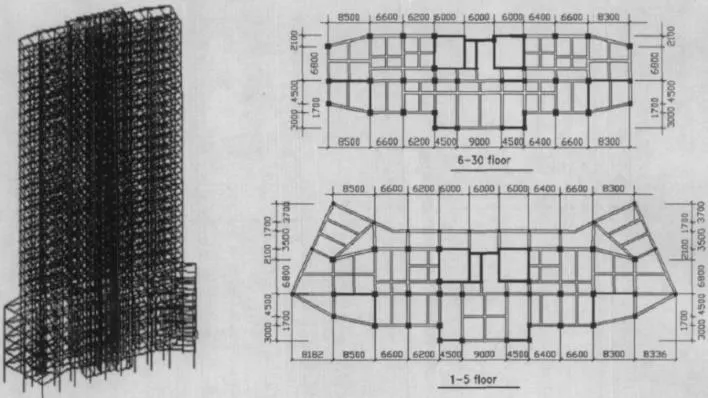
Figure2:Plane graph of standard floor
The optimal design has been made on 655 design variables for all columns and beams within the standard stories.Optimization processes of structure cost and inter-story lateral displacement angle have been listed in Fig.3 and Fig.4.During the strength optimization,the total cost of the structure after 17 iterations tends to be 16.57 million RMB.However,as the lateral displacement angle of the structure floor exceeds the allowable value,the stiffness optimization stage shall come into being and it converges to 17.78 million RMB after 7 iterations.Due to changes in the structural stiffness caused by the local section adjustment,the local components fail the strength requirements and it shall be returned to the strength optimization design.Finally,after three strength optimization designs and two stiffness optimization designs,the best structure design scheme is achieved.The total cost of 20.67 million RMB is reduced to 18.02 million RMB with a decreasing amplitude of 12.8%.
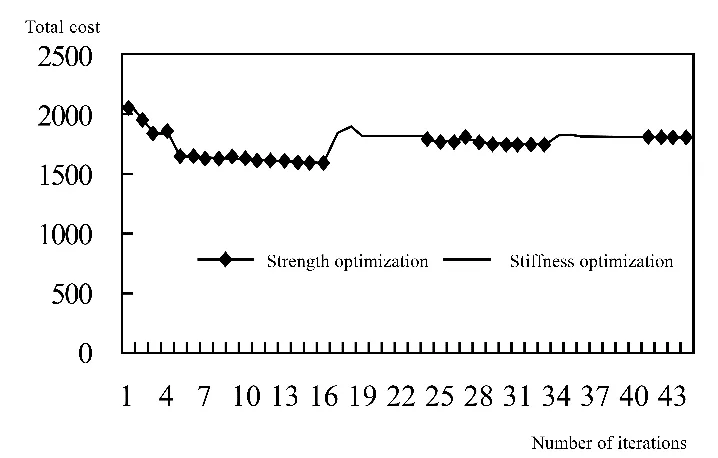
Figure3:Optimization process
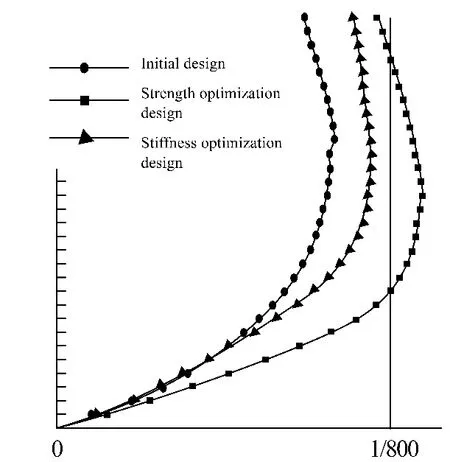
Figure4:Inter-story displacement angle
Fig.5 and Fig.6 list the variations of column section size and axial com-pression ratio within the first standard floor after the initial design and optimal design.After the optimal design,the column section size is greatly degraded while the axial compression ratio is greatly improved than that of the initial design.Axial compression ratio in the original design is too small and unevenly distributed.After the optimal design,the axial compression ratio is distributed between 0.5 and 0.6 and tends to be more reasonable.
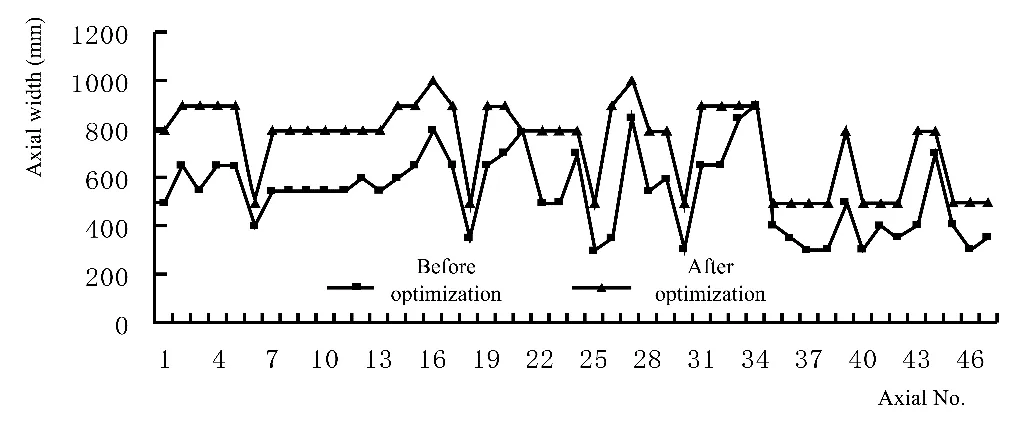
Figure5:Column section distribution before and after the optimization
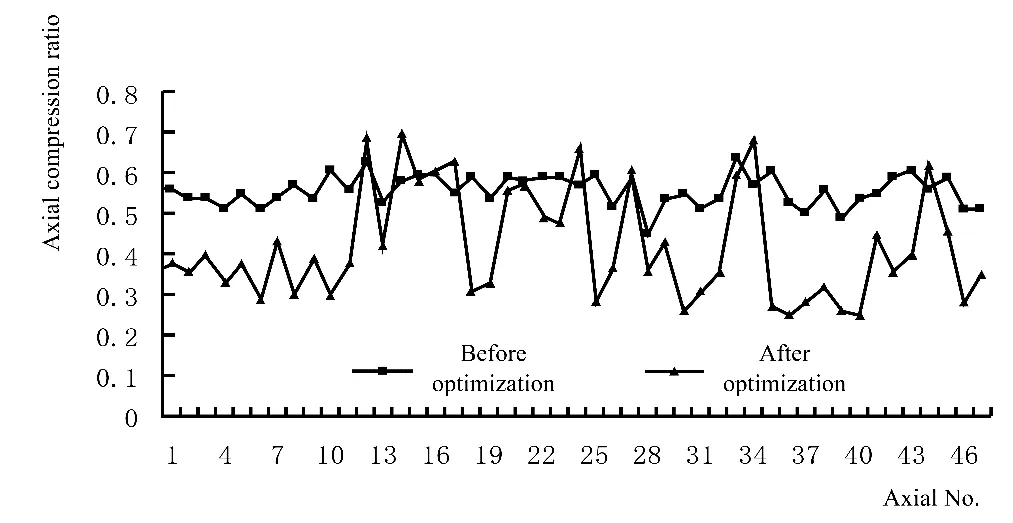
Figure6:Axial compression ratio distribution before and after the optimization
5 Conclusions
In the past optimal designs of building structures,the steel area in the calculation result is always used to calculate the cost of units without considering the specific reinforcement form and structural requirements,its object function is greatly different from the actual engineering and the optimization result is lower credible.In this paper,the unit (strength and stiffness) optimization and overall stiffness optimization in the first optimal design of building structure are proposed through the analysis and comparison of documents in combination with the characteristics of the building structure.The hybrid algorithm proposed in this paper has optimized the design of structure from the structural unit and overall stiffness.In terms of optimal model design and algorithm implementation,the actual model,computing method and software in the engineering are adopted to popularize the application of the optimization results.
 Computers Materials&Continua2019年3期
Computers Materials&Continua2019年3期
- Computers Materials&Continua的其它文章
- R2N:A Novel Deep Learning Architecture for Rain Removal from Single Image
- A Straightforward Direct Traction Boundary Integral Method for Two-Dimensional Crack Problems Simulation of Linear Elastic Materials
- Effect of Reinforcement Corrosion Sediment Distribution Characteristics on Concrete Damage Behavior
- Research on the Law of Garlic Price Based on Big Data
- Controlled Secure Direct Communication Protocol via the Three-Qubit Partially Entangled Set of States
- Modeling and Analysis the Effects of EMP on the Balise System
